An Arabian Ark
Pictures by Hanne & Jens Eriksen
The island nature reserve and experimental agricultural base of Sir Bani Yas has undergone a massive amount of land reclamation, planting, irrigation and wildlife husbandry creating a place that somehow defies all expectations in terms of what can grow and live in this southern Arabian Gulf region. Flourishing wildlife on the island probably reflects how the region once was, at a time of greater rainfall and greener pastures. Proposals were discussed with UNESCO during the year, concerning international recognition of this unique wildlife reserve with a view to enhancing its status as a wildlife conservation centre. The following account is extracted from the book Natural Emirates, published in November 1996.
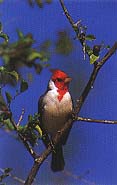 First impressions of the island of Sir Bani Yas depend upon one's method of approach. A boat-crossing of the narrow stretch of water between it and the mainland of Abu Dhabi at Jebel Dhanna, is dominated by sight of the island's cone-shaped central 'mountains', providing an easy navigational beacon. As one sails closer, these turn out to be a strange mixture of red, green and brown rock formations. Circumnavigating the island, it soon becomes apparent that there is much more to Sir Bani Yas than this unusual structure, for it is surrounded by gently sloping plains which merge with a fairly level coastal shelf. The shoreline itself ranges from mangrove covered sand-banks and hidden inlets, to buttressed foreshore and, finally, a well constructed small harbour at which one lands.
First impressions of the island of Sir Bani Yas depend upon one's method of approach. A boat-crossing of the narrow stretch of water between it and the mainland of Abu Dhabi at Jebel Dhanna, is dominated by sight of the island's cone-shaped central 'mountains', providing an easy navigational beacon. As one sails closer, these turn out to be a strange mixture of red, green and brown rock formations. Circumnavigating the island, it soon becomes apparent that there is much more to Sir Bani Yas than this unusual structure, for it is surrounded by gently sloping plains which merge with a fairly level coastal shelf. The shoreline itself ranges from mangrove covered sand-banks and hidden inlets, to buttressed foreshore and, finally, a well constructed small harbour at which one lands.
The approach by air, by helicopter, or indeed fixed wing aircraft, offers an entirely different view. Surrounded by a glittering blue sea the island stands out like a green emerald placed on a jewellers display cloth. First impressions are of its serried ranks of trees, which cover almost half its land area, and, secondly, its obvious abundance of wildlife. Large herds of gazelle skoot across the mountain side whilst over a hundred white Arabian oryx graze contentedly within their large enclosure. Close to the helicopter pad are more exotic wildlife: giraffe, emu and a range of African mammals. The helicopter ride itself is a noisy experience and after being deposited on firm ground, the whirling blades once more lift the craft skywards. Gradually, a beautiful peace and tranquillity descends, calming jagged nerves. Finally, with the aircraft gone, a sense of urgency builds up to explore on land everything that has just caught the eye from above.
Sir Bani Yas has attracted man for a long time. The central salt-plug of Jebel Wahid, for that is what geologists tell us forms the strange crystalline mountain, was not always surrounded by water. Towards the end of the last Ice Age, around 10,000 years ago, sea-level in the Gulf was considerably lower than it is today and much of the present day seabed was above high-water mark. At that time Sir Bani Yas was part of mainland Arabia and its craggy hills rose up above a green plateau on which a wide variety of wildlife flourished. This verdant countryside, watered by ancient rivers, undoubtedly attracted fishermen, hunters and gatherers and we have firm evidence of people living here between 6000 and 7000 years ago. Archaeological excavations on the island are being carried out by the Abu Dhabi Islands Archaeological Survey and whether it is a Late Stone Age site at which a flint 'tile-knife' was discovered, a fisherman's midden containing the remains of dugong and turtle bones, or the pre-Islamic Nestorian church and monastery with its intricate plaster embellishments, Sir Bani Yas's past is gradually being revealed in all its varied facets.
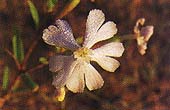 Throughout history this fascinating island has offered challenges and opportunities for those who chose to make it their home. For the people of the Bani Yas tribal confederation, after whom the island is named, it offered a refuge and staging post, with a safe anchorage, good fishing and the prized Gulf pearling beds nearby. Today the island is part of an unusual environmental and biological experiment. Initially Sheikh Zayed chose Sir Bani Yas as a place to spend time with his family, following an age old bedouin tradition that took advantage of the sea-breezes during the hot summer weather. A love of wildlife and nature led Zayed to the idea of sharing his island with endangered Arabian species such as sand gazelle and oryx. Little by little, year by year, he developed the island into a special reserve where wildlife holds pride of place and where visitors are able to gain a taste of how it must have been thousands of years ago, when this landscape resembled the savannahs of Africa and shared many species with its neighbouring continent.
Throughout history this fascinating island has offered challenges and opportunities for those who chose to make it their home. For the people of the Bani Yas tribal confederation, after whom the island is named, it offered a refuge and staging post, with a safe anchorage, good fishing and the prized Gulf pearling beds nearby. Today the island is part of an unusual environmental and biological experiment. Initially Sheikh Zayed chose Sir Bani Yas as a place to spend time with his family, following an age old bedouin tradition that took advantage of the sea-breezes during the hot summer weather. A love of wildlife and nature led Zayed to the idea of sharing his island with endangered Arabian species such as sand gazelle and oryx. Little by little, year by year, he developed the island into a special reserve where wildlife holds pride of place and where visitors are able to gain a taste of how it must have been thousands of years ago, when this landscape resembled the savannahs of Africa and shared many species with its neighbouring continent.
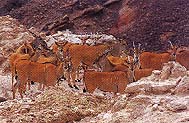 There are basically three kinds of 'enclosure' on the island, i.e. ones to keep animals within a defined area, ones that provide living space for humans, and finally the rest of the island in which a large number of animals roam at will. Among the latter are the Arabian or mountain gazelle (Gazella gazella cora), known to the locals as dhabi. It was this animal that gave the emirate its name since the island on which the capital city now stands is known as 'possession of the gazelle' or Abu Dhabi. Other gazelles include the more numerous rheem or sand gazelle (Gazella subgutterosa marica), dorcas gazelle (Gazella dorcas) and Grant's gazelle (Gazella granti), an East African species.
There are basically three kinds of 'enclosure' on the island, i.e. ones to keep animals within a defined area, ones that provide living space for humans, and finally the rest of the island in which a large number of animals roam at will. Among the latter are the Arabian or mountain gazelle (Gazella gazella cora), known to the locals as dhabi. It was this animal that gave the emirate its name since the island on which the capital city now stands is known as 'possession of the gazelle' or Abu Dhabi. Other gazelles include the more numerous rheem or sand gazelle (Gazella subgutterosa marica), dorcas gazelle (Gazella dorcas) and Grant's gazelle (Gazella granti), an East African species.
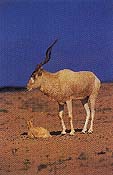 Arabian oryx (Oryx leucoryx), rescued only a few decades ago from the brink of extinction, are protected within their own compound which straddles a large section of the sloping plain beneath Jebel Wahid. Here they are free to wander over several square kilometres of natural landscape. The herd is steadily increasing in size as a result of natural breeding within the enclosure. This quietly undertaken effort, little known internationally, is testimony to Sheikh Zayed's deep seated concern for protection of Arabia's unique wildlife, so elegantly personified by the white oryx.
Arabian oryx (Oryx leucoryx), rescued only a few decades ago from the brink of extinction, are protected within their own compound which straddles a large section of the sloping plain beneath Jebel Wahid. Here they are free to wander over several square kilometres of natural landscape. The herd is steadily increasing in size as a result of natural breeding within the enclosure. This quietly undertaken effort, little known internationally, is testimony to Sheikh Zayed's deep seated concern for protection of Arabia's unique wildlife, so elegantly personified by the white oryx.
Also to be found wandering the open countryside, or held within other large enclosures, on this exotic island reserve are blackbuck (Antilope cervicapra), common eland (Taurotragus oryx), beisa oryx (Oryx gazella beisa), scimitar-horned oryx (Oryx dammah), Arabian oryx (Oryx leucoryx), addax (Addax nasomaculatus), defassa waterbuck (Kobus ellipsiprymnus defassa), fallow deer (Dama dama), axis deer (Axis axis), hog deer (Cervus porcinus), barbary sheep (Amnotragus lervia), and wild sheep or Asiatic mouflon (Ovis ammon).
One experiment of wildlife management that visitors are not encouraged to observe is a breeding pen for houbara (Chlamydotis undulata), members of the bustard family. These birds need to be left strictly alone if they are to to have any chance to breed successfully under wild conditions, and a large area close to the coast has been set aside just for that purpose. This island bird sanctuary is only part of the many efforts by Sheikh Zayed, and his family to revive the population of the houbara in the wild. At the National Avian Research Centre (NARC) at Sweihan on the mainland, a highly scientific approach is taken to captive breeding, while NARC scientists are also studying the migration and breeding patterns of the houbara.
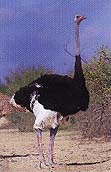 Sir Bani Yas's other birds are also impressive inhabitants of this Arabian ark. Whilst Arabia's native sub-species of ostrich (Struthio camelus syriacus) is sadly extinct, a captive population of closely related African ostrich is now breeding on the island. Meanwhile, successful breeding of two other flightless birds, the rhea (Rhea americana) and the emu (Dromaius naavaehollandiae) is raising the question of what to do with the rapidly increasing flocks. Another introduced bird, but one which now breeds in the wild on Sir Bani Yas, is the Egyptian goose (Alopochen aegyptius), whose adults, with goslings in tow, can be seen alongside the mangrove channel close to the main residential area. Other introductions include the ground nesting grey francolin (Francolinus pondicerianus), black francolin (Francolinus francolinus), see see (Ammoperdix griseogularis) and chukar partridge (Alectoris chukar). Some other free-flying species that have begun to breed include the African crowned crane (Balearica regulorum), helmeted guineafowl (Numidia meleagris), and possibly also the common pheasant (Phasianus colchicus).
Sir Bani Yas's other birds are also impressive inhabitants of this Arabian ark. Whilst Arabia's native sub-species of ostrich (Struthio camelus syriacus) is sadly extinct, a captive population of closely related African ostrich is now breeding on the island. Meanwhile, successful breeding of two other flightless birds, the rhea (Rhea americana) and the emu (Dromaius naavaehollandiae) is raising the question of what to do with the rapidly increasing flocks. Another introduced bird, but one which now breeds in the wild on Sir Bani Yas, is the Egyptian goose (Alopochen aegyptius), whose adults, with goslings in tow, can be seen alongside the mangrove channel close to the main residential area. Other introductions include the ground nesting grey francolin (Francolinus pondicerianus), black francolin (Francolinus francolinus), see see (Ammoperdix griseogularis) and chukar partridge (Alectoris chukar). Some other free-flying species that have begun to breed include the African crowned crane (Balearica regulorum), helmeted guineafowl (Numidia meleagris), and possibly also the common pheasant (Phasianus colchicus).
The success of Sir Bani Yas as a nature reserve is further underlined by the number of wild bird species that made it a temporary or permanent home. Details of sightings of around 170 species are now kept in the files of the Emirates Bird Records Committee. Among these, a popular favourite is the greater flamingo (Phoenocopterus ruber), also known as the pink flamingo, which can be seen in shallow intertidal lagoons, protected by mangrove bushes, or at the artificial 'bird lake' where they can gather in dense flocks of over a hundred individuals.
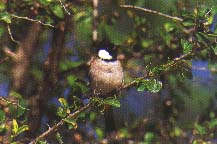 Sheikh Zayed's success in creating a wildlife reserve has been matched by the results of field trials in which the island has been used as a testing ground for agriculture. One of the first plants that he encouraged to grow on the island was a species that has been much maligned elsewhere in the world, and which has suffered greatly at the hands of developers, the humble mangrove tree (Avicennia marina). For someone who knows the true value of freshwater and the real dryness of the desert, a tree that grows in sea-water creates a powerful impression. So powerful, in fact, that Sheikh Zayed has had agricultural teams planting new stands of these salt-tolerant bushes all along the coast of Abu Dhabi for the past 20 or so years, both in areas where they were previously present and in new areas, often along the edge of reclaimed land. Not only has this practice formed new stretches of coastal greenery, but it has also created important habitats for many birds, insects, fish and marine invertebrates. Such efforts are making new nursery grounds for commercial fish, as well as aesthetically pleasing coastal features.
Sheikh Zayed's success in creating a wildlife reserve has been matched by the results of field trials in which the island has been used as a testing ground for agriculture. One of the first plants that he encouraged to grow on the island was a species that has been much maligned elsewhere in the world, and which has suffered greatly at the hands of developers, the humble mangrove tree (Avicennia marina). For someone who knows the true value of freshwater and the real dryness of the desert, a tree that grows in sea-water creates a powerful impression. So powerful, in fact, that Sheikh Zayed has had agricultural teams planting new stands of these salt-tolerant bushes all along the coast of Abu Dhabi for the past 20 or so years, both in areas where they were previously present and in new areas, often along the edge of reclaimed land. Not only has this practice formed new stretches of coastal greenery, but it has also created important habitats for many birds, insects, fish and marine invertebrates. Such efforts are making new nursery grounds for commercial fish, as well as aesthetically pleasing coastal features.
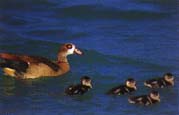 But the most visible achievements at Sir Bani Yas are on dry land where hundreds of acres of old or reclaimed land have been planted with millions of trees and shrubs. Whilst some of these are grown to provide shade and comfort for wild animals, or simply to green the landscape, some are part of food growing experiments that aim to test new ideas and to find species that show the greatest tolerance for Abu Dhabi's hot arid climate.
But the most visible achievements at Sir Bani Yas are on dry land where hundreds of acres of old or reclaimed land have been planted with millions of trees and shrubs. Whilst some of these are grown to provide shade and comfort for wild animals, or simply to green the landscape, some are part of food growing experiments that aim to test new ideas and to find species that show the greatest tolerance for Abu Dhabi's hot arid climate.
| Subjects | Search
Arabian Wildlife. Volume 3, Number 1